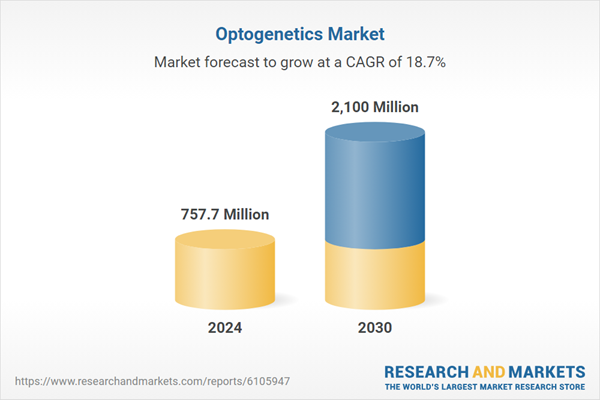Global Optogenetics Market - Key Trends & Drivers Summarized
How Is Optogenetics Transforming Neuroscience and Cellular Research?
Optogenetics is an advanced technique that uses light to control cellular activity in genetically modified cells, particularly neurons. This method allows researchers to manipulate specific cells in real time using light-sensitive proteins, offering unprecedented control over neural circuits and signaling pathways. The approach is revolutionizing neuroscience by enabling detailed mapping of brain activity and understanding of complex neurological behaviors, including those linked to disorders such as Parkinson's disease, epilepsy, and depression.Beyond brain research, optogenetics is being explored in cardiology, pain studies, and vision restoration. Its precision and speed make it more effective than pharmacological or electrical stimulation in many contexts. By targeting defined cell populations, optogenetics supports selective activation or inhibition of biological pathways, providing researchers with a tool to probe function at a fine-grained level.
What Technological Innovations Are Expanding the Application Scope?
Recent developments in genetic engineering, viral vector design, and light delivery systems are enhancing the utility of optogenetic methods. New light-sensitive ion channels and opsins are being engineered for activation at different wavelengths and intensities, enabling deeper tissue penetration and reduced thermal damage. These include red-shifted and near-infrared responsive opsins suited for in vivo use.Miniaturized fiber-optic systems, wireless light delivery devices, and optoelectronic implants are enabling long-term studies in freely moving animal models. Integration with two-photon microscopy, electrophysiology, and functional MRI is supporting multimodal experiments. Advances in CRISPR and viral vector systems are improving gene expression targeting, reducing off-target effects, and expanding applicability beyond the central nervous system.
Where Is Adoption Growing and Which Fields Are Accelerating Research?
Adoption of optogenetics is expanding within academic neuroscience laboratories, pharmaceutical research institutions, and translational medicine programs. North America and Europe lead in research intensity, while Asia-Pacific countries are rapidly increasing investment in neurobiology and bioengineering. Universities and research institutes are applying optogenetics to model psychiatric and neurodegenerative disorders and to explore brain-machine interfaces.Emerging areas of interest include retinal regeneration, cardiac rhythm modulation, and immune cell signaling studies. Biotechnology firms are investigating optogenetic tools as part of preclinical drug screening, behavioral analysis, and biosensor development. Despite technical complexity, interest in clinical translation is growing, especially for restoring vision and addressing treatment-resistant neurological conditions.
Growth in the Optogenetics market is driven by several factors…
Growth in the optogenetics market is driven by factors such as increasing neuroscience research, rising adoption of precision cell control tools, and continuous innovation in gene delivery and light activation technologies. Demand for advanced neurostimulation methods in academic and translational settings is pushing development of more efficient, customizable optogenetic tools.The ability to integrate optogenetics with live imaging, behavioral assays, and electrophysiology is enhancing its role in systems biology. Rising investment in neural circuit mapping, psychiatric disorder research, and vision restoration technologies is reinforcing market expansion. Improvements in opsin sensitivity, expression control, and implantable light systems are broadening real-world applicability and sustaining momentum in both research and early clinical domains.
Report Scope
The report analyzes the Optogenetics market, presented in terms of market value (US$). The analysis covers the key segments and geographic regions outlined below:- Segments: Optogenetics Type (Type I Optogenetics, Type II Optogenetics).
- Geographic Regions/Countries: World; United States; Canada; Japan; China; Europe (France; Germany; Italy; United Kingdom; and Rest of Europe); Asia-Pacific; Rest of World.
Key Insights:
- Market Growth: Understand the significant growth trajectory of the Type I Optogenetics segment, which is expected to reach US$1.3 Billion by 2030 with a CAGR of a 17%. The Type II Optogenetics segment is also set to grow at 21.7% CAGR over the analysis period.
- Regional Analysis: Gain insights into the U.S. market, valued at $199.2 Million in 2024, and China, forecasted to grow at an impressive 17.8% CAGR to reach $327.4 Million by 2030. Discover growth trends in other key regions, including Japan, Canada, Germany, and the Asia-Pacific.
Why You Should Buy This Report:
- Detailed Market Analysis: Access a thorough analysis of the Global Optogenetics Market, covering all major geographic regions and market segments.
- Competitive Insights: Get an overview of the competitive landscape, including the market presence of major players across different geographies.
- Future Trends and Drivers: Understand the key trends and drivers shaping the future of the Global Optogenetics Market.
- Actionable Insights: Benefit from actionable insights that can help you identify new revenue opportunities and make strategic business decisions.
Key Questions Answered:
- How is the Global Optogenetics Market expected to evolve by 2030?
- What are the main drivers and restraints affecting the market?
- Which market segments will grow the most over the forecast period?
- How will market shares for different regions and segments change by 2030?
- Who are the leading players in the market, and what are their prospects?
Report Features:
- Comprehensive Market Data: Independent analysis of annual sales and market forecasts in US$ Million from 2024 to 2030.
- In-Depth Regional Analysis: Detailed insights into key markets, including the U.S., China, Japan, Canada, Europe, Asia-Pacific, Latin America, Middle East, and Africa.
- Company Profiles: Coverage of players such as Ametek Optics (Ametek Inc.), Angénieux (Thales Group), Bausch + Lomb, Canon Inc., Carl Zeiss AG and more.
- Complimentary Updates: Receive free report updates for one year to keep you informed of the latest market developments.
Some of the 41 companies featured in this Optogenetics market report include:
- Addgene
- Applied Genetic Technologies Corp.
- Bruker Corporation
- Bionic Sight LLC
- Campden Instruments
- Circuit Therapeutics Inc.
- Cobolt Inc.
- Coherent Inc.
- Danaher Corporation
- Elliot Scientific Ltd.
- GenSight Biologics
- GenScript Biotech Corporation
- Hubner Photonics Inc.
- Inscopix
- Jackson Laboratory
- Judges Scientific Plc
- Laserglow Technologies
- Lumentum Holdings Inc.
- Merck KGaA
- Mightex Systems
This edition integrates the latest global trade and economic shifts into comprehensive market analysis. Key updates include:
- Tariff and Trade Impact: Insights into global tariff negotiations across 180+ countries, with analysis of supply chain turbulence, sourcing disruptions, and geographic realignment. Special focus on 2025 as a pivotal year for trade tensions, including updated perspectives on the Trump-era tariffs.
- Adjusted Forecasts and Analytics: Revised global and regional market forecasts through 2030, incorporating tariff effects, economic uncertainty, and structural changes in globalization. Includes historical analysis from 2015 to 2023.
- Strategic Market Dynamics: Evaluation of revised market prospects, regional outlooks, and key economic indicators such as population and urbanization trends.
- Innovation & Technology Trends: Latest developments in product and process innovation, emerging technologies, and key industry drivers shaping the competitive landscape.
- Competitive Intelligence: Updated global market share estimates for 2025, competitive positioning of major players (Strong/Active/Niche/Trivial), and refined focus on leading global brands and core players.
- Expert Insight & Commentary: Strategic analysis from economists, trade experts, and domain specialists to contextualize market shifts and identify emerging opportunities.
Table of Contents
Companies Mentioned (Partial List)
A selection of companies mentioned in this report includes, but is not limited to:
- Addgene
- Applied Genetic Technologies Corp.
- Bruker Corporation
- Bionic Sight LLC
- Campden Instruments
- Circuit Therapeutics Inc.
- Cobolt Inc.
- Coherent Inc.
- Danaher Corporation
- Elliot Scientific Ltd.
- GenSight Biologics
- GenScript Biotech Corporation
- Hubner Photonics Inc.
- Inscopix
- Jackson Laboratory
- Judges Scientific Plc
- Laserglow Technologies
- Lumentum Holdings Inc.
- Merck KGaA
- Mightex Systems
Table Information
| Report Attribute | Details |
|---|---|
| No. of Pages | 107 |
| Published | December 2025 |
| Forecast Period | 2024 - 2030 |
| Estimated Market Value ( USD | $ 757.7 Million |
| Forecasted Market Value ( USD | $ 2100 Million |
| Compound Annual Growth Rate | 18.7% |
| Regions Covered | Global |









